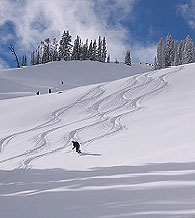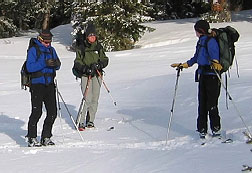For your own safety, take an Avalanche Safety Course.
This is one of a series of Avalanche Awareness articles on the Mountain Equipment Co-op website in Canada. Other articles in this series have described the three physical factors that produce avalanches: terrain, snowpack, and weather. In this article, we'll look at psychological factors that play a role in avalanche accidents. Even when people have extensive training and experience in avalanche terrain, "human factors" can blind them to dangerous avalanche conditions. We'll look at the most common human factors, where they come from, and how to minimize their hazards.
"What Were They Thinking?!"
In hindsight, in the comfort of a classroom or bar, it's usually easy to see why an avalanche accident occurred. Perhaps the party chose to ski or ride a dangerously wind-loaded slope, enter a terrain trap during high avalanche danger, or continue climbing despite signs of recent avalanching. Working backward from a tragic outcome, the danger seems obvious to us and we wonder why anyone would take chances under such dangerous conditions. The easy answer is that the party must have been incompetent, arrogant, or just plain foolish. These answers help us feel better about ourselves since, after all, we wouldn't act like that. But they don't lead us to a better understanding of how we might be fooled some day into making the same mistakes.
To really understand human factors, we need to go back in the accident timeline. We need to imagine ourselves standing at the top of the slope, trying to decide if it is safe to ski or ride. Perhaps we've seen the signs of danger, but we also know that we have skied the slope many times before without incident. Or perhaps we know that another party is powering up behind us intent on skiing the same slope. Or perhaps we've waited all year for this vacation so we could highmark slopes just like this one.
Such knowledge tends to blur our judgment and tempt us into believing that it's OK to take a chance on this slope today. These influences operate in the shadowy edges of our subconscious, and we are often oblivious to their effects on our behavior. Fortunately, there are predictable patterns in how these unconscious influences affect our decisions. It turns out that these same patterns appear whenever we face physical hazards such as driving, unsafe sex, taking drugs and, yes, dealing with avalanches. These patterns are well known in areas such as advertising and health psychology, but their lessons apply to decision making in avalanche terrain as well.
What Are Common Human Factors?
In a recent analysis of avalanche accidents in the United States, consistent patterns emerged in the decision making of avalanche victims. Here are six of the most common:
Familiarity
Parties traveling in familiar terrain made significantly riskier decisions than parties traveling in unfamiliar terrain. This effect was especially pronounced for parties with substantial experience and training.
Acceptance
Accident parties that included females made riskier decisions than parties of all males. The effect was most pronounced in parties with little avalanche training. It is notable that these were precisely the parties in which women were least likely to participate.

Most avalanche accidents occured in popular areas on slopes that were familiar to the victims.
Consistency
Parties that were highly committed to a goal - a summit, ski slope or an objective in deteriorating weather - made riskier decisions than parties just out for a day of skiing, climbing or sledding. This effect was most pronounced in parties of four or more.
Experts
Accident parties often contained a de facto leader - someone who was more experienced, older, or who had better skills. Remarkably, when this leader had poor avalanche skills, novice groups were more likely to follow their leader into dangerous situations than when novice groups made decisions by consensus.
Tracks/Scarcity
Parties took more risks when they were racing a closing window of opportunity, such as competing with another group for first tracks.
Social Facilitation
When skilled parties met other people in the backcountry, they were more likely to take risks than parties that were less skilled. This effect, known as social facilitation, was most pronounced in groups with the highest levels of training.
These results are preliminary, but they mirror patterns that have been observed in other areas of risk taking and human behavior. It appears that when certain psychological cues are present, people find it difficult to heed more objective cues about avalanche hazard. The important lesson here is that these psychological cues have very little to do with avalanche conditions and a lot to do with our unconscious assumptions, biases, and habits.
What Can We Do About Human Factors?
Human factors are part of being human. They are essential to efficiently navigating the complexities of everyday life. Try as we might, we can't simply talk ourselves out of relying on them, but we may be able to recognize when we are most prone to their negative influences and stop a bad decision in its tracks.
First, travel with partners you can talk to.
In a common accident scenario, a party gets spread out in avalanche terrain, with no specific plan to re-group and re-assess conditions. The person out front makes their own route finding decisions and the group follows, often with increasing alarm about what they see around them. When the avalanche releases, the victims are often well aware of the risks they were taking.
To avoid this situation, travel in parties that communicate about avalanche conditions. You don't need a running commentary, just a friendly discussion at key points in the tour about what folks are seeing and experiencing. It helps to agree beforehand on where the key decision points are, and have a common language for discussing avalanche conditions and risk tolerance.
Second, identify when the risk level is rising.
To catch an accident before it happens, try a pre mortem test: Ask yourself, if an accident occurs, what would I have missed? Imagine your buddies sitting in the bar after your accident, wondering how you made your decision to ski or highmark that slope. If you can enumerate more than two or three obvious signs of avalanche danger, you are probably taking significant risks. And your feeling that "everything will work out OK" will, in hindsight after an accident, look to them more like recklessness or worse

Good communication within your party is essential to recognizing changing avalanche conditions.
Need help figuring out how much risk you are actually taking? Click here for some information.
Third, assess how objective you are about the risk.
We've seen that in the face of certain psychological cues, it's difficult to be objective about avalanche hazard. Even experience and training are no guarantee. A simple way to find out what you're up against is to perform a FACETS test.
FACETS is an acronym listing the human factors previously described:
and it can help you remember the psychological cues that can obscure your perception of avalanche conditions. In the FACETS test, you simply run through the list and see which cues are present. Depending on your experience, group size, and other factors, each cue may have a different level of influence on your objectivity. But in general, the more cues that are present, the more difficult it will be for you to objectively assess the danger. Like an unstable snowpack, it doesn't matter what the depth of your avalanche knowledge and experience is if your decisions rest on weak assumptions.
It's important to recognize that tools like the pre mortem and FACETS tests are in a very early stage of evolution, and they do not cover all possible combinations of avalanche hazard and human factors. They may not be perfect, but they can get you started down the road of recognizing trouble before it strikes. And they will make it less likely that someday, a bar room debate about your group will make people wonder, "What were they thinking?!"
Details of McCammon's study can be downloaded in Acrobat PDF format (123KB) here.